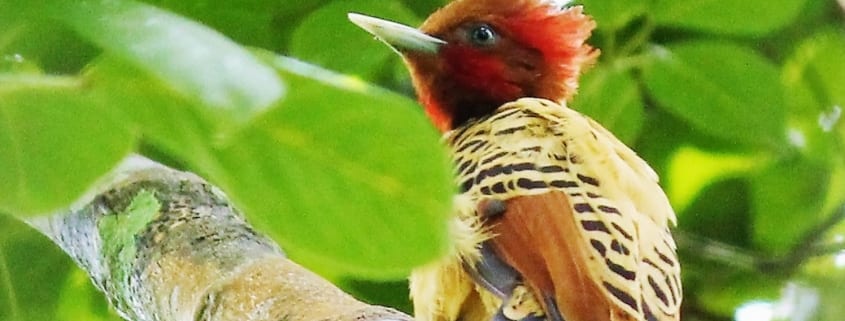First Protection for the Rediscovered Kaempfer’s Woodpecker in Brazil
The Kaempfer’s Woodpecker, once thought extinct, now has its first protected habitat through a 593-acre land purchase in central Brazil’s Cerrado biome, the world’s most biodiverse tropical savanna.
The Cerrado biome of central Brazil is the world’s most biodiverse tropical savanna. Due to its high agricultural potential, it is also one of the most threatened biodiversity hotspots in the world: 80 percent of its original area is already gone, and protected areas safeguard only 3 percent of the remaining habitat.
In the Araguaia Valley of central Brazil, moist lowland Cerrado woodland comes into direct contact with Amazonian flooded forest, resulting in very high levels of biodiversity. Within this imperiled landscape lives the Endangered Kaempfer’s Woodpecker, originally discovered 80 years ago but then thought to be extinct until it was rediscovered in the region in 2006. Its habitat consists of bamboo thickets, semi-open Cerrado and successional areas on the edge of dense Cerrado woodland. This woodpecker depends on the Cerrado landscape as it forages on ants within the bamboo thickets. While their range is relatively large, scientists believe the overall population is extremely small and the birds occur only in scattered patches of Cerrado habitat interspersed with bamboo. This landscape also supports Endangered Giant Otters that prefer large, slow-moving rivers and lakes with high fish densities.
Unfortunately, only the Amazonian part of this region is protected through Cantão State Park and Araguaia National Park. The Cerrado portion of the Cantão ecosystem is comprised of private lands undergoing rapid deforestation, which provide the vast majority of Brazil’s annual soybean harvest. High land costs and Brazil’s economic dependence on agricultural exports make establishing government protected areas unfeasible and politically challenging, leaving private conservation areas as the only viable alternative.
“The Cerrado is one of the most precious habitats in Brazil and it is being lost to soybean production. Safeguarding this habitat and creating the first refuge for this spectacular Endangered woodpecker is a great relief for both the landscape and species,” Rainforest Trust CEO Dr. Paul Salaman said.
Rainforest Trust and local partner Instituto Araguaia sought to conserve a portion of the Araguaia Valley through the purchase of a 593-acre private property that encompasses Kaempfer’s Woodpecker habitat next to Cantão State Park. The new reserve, called Canto do Obrieni, has exceptional levels of biodiversity for Central Brazil and provides habitat for both of the Endangered species that live in the region: the Giant Otter and Kaempfer’s Woodpecker.
The property also supports seven Vulnerable species: the Lowland Tapir, White-lipped Peccary, Marsh Deer, Giant Anteater, Giant Armadillo, Bananal Antbird and Chestnut-bellied Guan. Within the 2 mile-wide buffer zone of Cantão State Park, there are 435 species of birds, 298 species of fish and an abundance of megafauna. In addition to Endangered and Vulnerable species, this area is also home to imperiled Black Caimans, Jaguars, Arapaima fish and the newly discovered Araguaia River Dolphin.
The new reserve will be registered with the federal government as a private nature reserve (RPPN) to add an extra layer of protection for the property and serve as an example for other landowners interested in establishing reserves on their own properties in the future. In addition to purchasing this key property and establishing an RPPN, the long-term goal is to launch a landscape-scale initiative to work with landowners to establish a network of private reserves across approximately 5,000 acres.
With the support of our many generous friends around the world and the SAVES Challenge, this project is a success. A special thank you to Jazmyn McDonald, Beverly Spector and Ken Lipson for their leadership gifts.
For more information on how you can support Rainforest Trust, visit our Conservation Action Fund.




